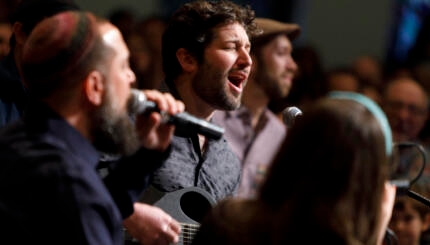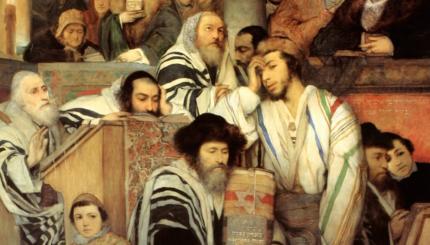One of the perennial dilemmas that confronts Jewish prayer is the challenge of achieving concentrated attention within a fixed liturgy. Jewish thinkers have long wrestled with this challenge and devised strategies, both conceptual and practical, to reconcile this binary of practice and spirit.
The problem has been resolved primarily in the domain of kavanah, the Hebrew term for a desired focus or directed attention. This heightened state of mental concentration ranges from a basic practice of mindfulness—simply attending to the words that one utters in prayer—to elaborate schemes of connecting spiritual realms, and even ascending through them.
In perhaps the first prescriptive statement in Jewish literature regarding kavanah in prayer, the Mishnah (Berachot 5:1) states:
[One] should not stand up to pray unless he is in a reverent frame of mind. The original pious ones used to wait a while and then pray, in order to direct their hearts towards the Omnipresent. [While one is reciting Shemoneh Esrei,] even if the king greets him, he should not respond to him, and even if a snake is coiled around his heel, he should not cease.
The Jerusalem Talmud relates a series of colorful methods used by different rabbis to prepare their minds for prayer. Rabbi Hiyya meditated on the Persian political hierarchy to help him concentrate. Rabbi Samuel counted birds. And Rabbi Bun bar Hiyya counted rows of bricks. These latter approaches are strikingly similar to the simple act of counting one’s breaths as a means to calm the mind, a method used in mindfulness meditation as practiced today. In the Babylonian Talmud, we read about diverse kinds of legal matters that one should contemplate in order to put oneself in a reverent frame of mind for prayer.

Help us keep Jewish knowledge accessible to millions of people around the world.
Your donation to My Jewish Learning fuels endless journeys of Jewish discovery. With your help, My Jewish Learning can continue to provide nonstop opportunities for learning, connection and growth.
By the medieval period, Jewish thinkers were beginning to offer more detailed prescriptions for how to attain proper kavanah. Moses Maimonides (1135–1204), the most famous medieval philosopher, wrote that any prayer that lacks proper concentration does not constitute prayer. But how to achieve that concentration?
In his legal code, the Mishneh Torah, Maimonides recommends clearing one’s thoughts, and sitting for a time before beginning prayer. But in his philosophical work, the Guide of the Perplexed, Maimonides proposes an even more rigorous program for mystical contemplation during the recital of the and the beginning of the daily Amidah prayer:
The first thing that you should cause your soul to hold fast onto is that while reciting the Shema you should empty your mind of everything and pray thus. You should not content yourself with being intent while reciting the first verse of Shema and saying the first blessing [of the Amidah]. When this has been carried out correctly and has been practiced consistently for years, cause your soul, whenever you read or listen to the Torah or listening to it, to be constantly directed—the whole of you and your thought—toward reflection on what you are listening to or reading… (Guide of the Perplexed 3:51).
In this remarkable passage, Maimonides reveals the depth of commitment required to develop the ideal form of kavanah. This is not for the faint of heart. Maimonides prescribes a practice that tilts decidedly toward non-verbal contemplation as the highest form of worship. In this treatment, inner religious awareness, self-effacement, and a pervasive focus upon divinity constitute the aim, rather than observance with a patina of spirituality.
In Maimonides’ wake—and partially in response to his unmatched influence — came the flourishing of a new and distinctive form of Jewish mysticism, known as Kabbalah. Jewish mysticism was not a new phenomenon, but the kabbalistic literature of the 12th century and onward provided novel forms of Jewish spirituality.
The kabbalists described divinity as comprising ten aspects or rungs called sefirot. Since the Torah is conceived as a revelation of God’s own being, every word or phrase, even its unwritten vowels and cantillation notes, signifies one of the sefirot. This approach makes space for the interpretation of a verse from the Torah as a complex string of sefirot.
Kabbalistic thinking extended the esoteric significance of the words of the Torah to the liturgy. Each word or prayer unit symbolizes a specific sefirah. Kavanah is the technique for uniting aspects of one’s heart, mind and soul with these higher cosmic meanings of the prayer text.
In one passage, the Zohar, the central work of Jewish mysticism, explains that through the mental act of concentration one causes one’s entire being to be constituted as a human tabernacle, prepared to receive divine overflow. Another passage explains that the 248 words of the Shema not only correspond to the 248 limbs of the human body (as per rabbinic teaching), but with the proper intent, reciting them joins together the 248 limbs of the divine body. Further, one is instructed to avoid any interruption between the blessings for the Shema and the recital of the whispered Amidah prayer in order to conjoin the masculine and feminine potencies of divinity.
In the hands of 16th-century kabbalists, and elaborated by many more subsequently, the approaches to kavanah became increasingly technically complex. At the same time, the popularization of kabbalistic attention to kavanah led to the appearance of various formulas to be recited before the recitation of particular prayers. Many of these were variations of the following: “For the sake of the unification of the blessed Holy One and His Shechinah, in fear and in love, in love and in fear, through unification of the name yod he with vav he [the letters of the tetragrammaton, YHVH] in the name of all of Israel.”
With the rise of the Hasidic movement in Eastern Europe in the 18th century, with its emphases on joy and communion with the divine, the desire for simpler metaphors and symbols led to the marginalizing of more technical kavanot. Yet, with the advent of cheaper printing, the simple kabbalistic kavanah quoted above became widespread, particularly in Hasidic prayerbooks. Indeed, this popularizing movement made kavanah—whether as rudimentary formulas or as emotive expression—the preeminent focus of religious life.
A letter from Israel Baal Shem Tov, traditionally thought of as the founder of Hasidic Judaism, instructed his brother-in-law to sustain a particular technique of intention during prayer and Torah study. He explained that “in every single letter there are worlds and souls and divinity. These ascend and bond and unite with each other. Then, the letters bond and unite with each other, becoming a word, and they unite in true unity with divinity. Include your soul with them in each and every aspect.”
One of the most basic Hasidic teachings is that the entire material world, and even more so the letters of Torah and of prayer, pulsate with divine energy and godly luminosity. Through envisioning the spirituality within each letter of one’s prayer, every Hasid could unite with holiness and participate in bringing unity to the fractured reality they experienced. Ecstasy was within reach!
The story of kavanah’s trajectory continues to our day. The 1960s witnessed a proliferation of Eastern and New-Age spirituality, in tandem with a popularization of the study of kabbalah. To the extent that these efforts are invested in sincere spiritual searching, they often involve the use of kavanot in prayer and contemplation. Of late, there has been great creativity in developing new kavanot adapted for new forms of prayer and spiritual practice. At the same time, a small but significant number of Jews who are trying to deepen their literacy have also turned to traditional formulas, infused with a new spirit. Indeed, kavanah may today be the subject of the greatest amount of spiritual attention in the English-speaking Jewish world.



